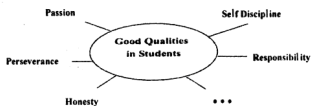题目内容
14.Every electronic gadget (小玩意) needs good memory.A music player stores songs,albums and playlists.A computer holds schoolwork and programs and remembers how far a player has advanced in his or her favorite game.Mobile phones store names,numbers and hundreds of texts.Now,scientists in California say they have come up with a way to turn a living cell into a memory device.
It can store only one tiny bit of information,but it's a start.In the future,a cell-based gadget might travel through the body and record measurements.The benefit to human health could be big:the right tool,for example,might record the earliest signs of disease.
Doctors,scientists and other curious people want to know what is happening inside the body,even at levels that can't be seen by the naked eye.So far,there is no device small enough to travel through the bloodstream.
If normal machines won't do the trick,perhaps biology will.Scientists who work in the field of synthetic (合成的) biology are trying to find ways to turn living things into human tools.In the case of the new memory device,bioengineers from Stanford University used the genetic material inside living cells to record information.
This genetic material consists of DNA.Found in nearly every cell,DNA carries all of the information that keeps a living thing alive.
In the new experiment,the researchers turned DNA from bacteria(细菌) into a switch.They"flip (翻转)"a small section of DNA.Then,using the same procedure (过程),the scientists flip the section again-returning it into its normal structure.
Using these DNA switches,"We can write and erase DNA in a living cell,"bioengineer,Jerome Bonnet,explained to Science News.
It might take years before his team or others identity whether a DNA-based memory device might be practical.Right now,it takes one hour to complete a flip.That is far too long to be useful.Plus,a flipped section has a very small little memory-less than what a computer uses to remember a single letter.
"This was an important proof that it was doable,"Bonnet told Science News."Now we want to build a more complex system,something that other people can use."
67.What is the aim of listing the electronic things in the first paragraph?D
A.To make the passage more fashionable.
B.To show how electronic things have memory.
C.To discuss things in detail.
D.To make the subject of the text more understandable.
68.What is possible future benefit of the cell-based gadget for people?A A.To detect disease at the earliest point.
B.To help improve the memory.
C.To help people build a body.
D.To replace many electronic gadgets.
69.What is the object being researched?B
A.The cells of bacteria.
B.The DNA of bacteria.
C.A section of bacteria.
D.The nucleus of bacteria.
70.What do we know about a flipped section of DNA?A
A.It has a very small memory.
B.It can function as a computer.
C.It has one letter in it.
D.It takes a day to complete it.
分析 本文属于科教类的短文阅读.主要介绍了科学家已经成功把活细胞植入了记忆装置以及现在科学家正在研究细菌的DNA.
解答 DABA
67:D.推断判断题.第一自然段列举电子事物的目的是使得这篇文章的主题更容易理解,故选D.
68:A.细节理解题.根据It can store only one tiny bit of information,but it's a start.In the future,a cell-based gadget might travel through the body and record measurements.The benefit to human health could be big:the right tool,for example,might record the earliest signs of disease.可知它的好处在于可以早期发现疾病,故选A.
69:B.细节理解题.根据In the new experiment,the researchers turned DNA from bacteria(细菌) into a switch.They"flip (翻转)"a small section of DNA.Then,using the same procedure (过程),the scientists flip the section again-returning it into its normal structure.可知正在被研究的物体是细菌的DNA,故选B.
70:A.细节理解题.根据最后一段That is far too long to be useful.Plus,a flipped section has a very small little memory-less than what a computer uses to remember a single letter.可知,它的记忆存储量是非常小的,还不及电脑记忆一个字母的量大;故选A.
点评 解答细节理解题时,一个常用的方法就是运用定位法,即根据题干和选项中的关键词从原文中找到相关的句子,与选项进行比较从而确定答案;推理判断题既要求学生透过文章表面文字信息推测文章隐含意思,又要求学生对作者的态度、意图及文章细节的发展作正确的推理判断,力求从作者的角度去考虑,不要固守自己的看法或观点.

